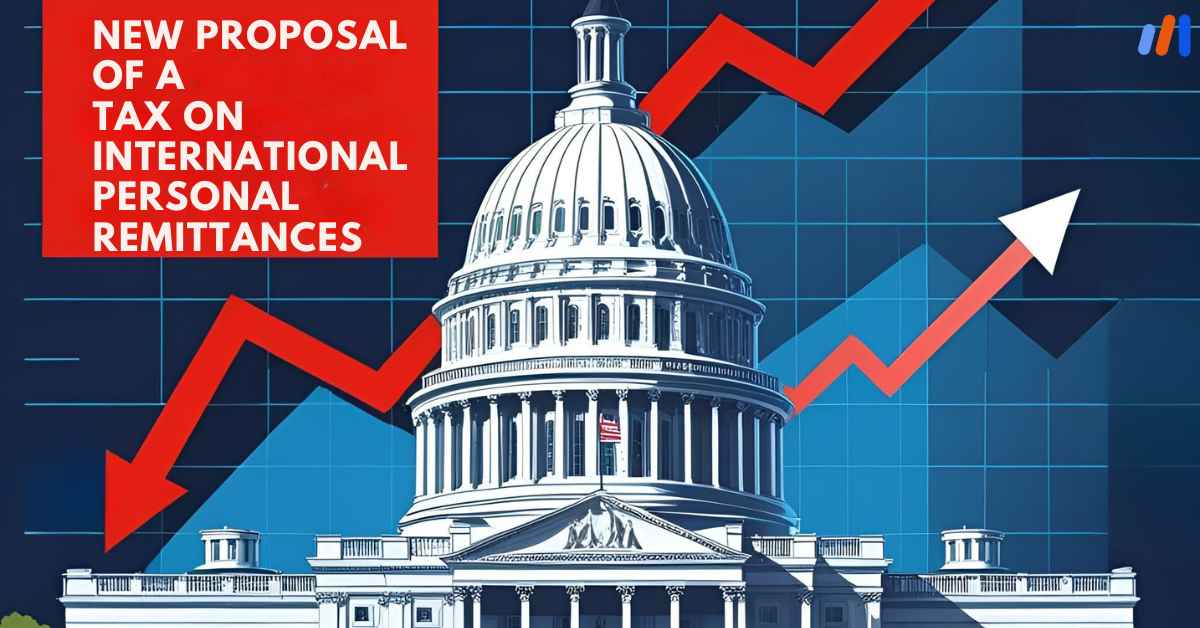With increased globalization, the US Government’s Proposed Remittance Tax came into the spotlight around 2025. This recently suggested excise tax specifically targets individuals who transfer funds from personal US bank accounts to foreign payees. It has already reached the House and is anticipated to sail through the other legislative gauntlets this year.
As of now, the remittance tax is set at 3.5%, after initially proposing 5%. This has far-reaching consequences. For US citizens, green card holders, and immigrant families who regularly send funds overseas, this translates to increased costs and tighter scrutiny for a tax they previously didn’t pay.
In this comprehensive guide, we will discuss what the proposed tax is, who it impacts, what the compliance complexities are, how to legally navigate around it, and how to get ready.
What is the US Government’s Proposed Remittance Tax?
The US Government Proposed Remittance Tax is a federal excise tax on individuals’ international money transfers for non-business, personal reasons. Specifically, it focuses on remittances from personal US bank accounts to overseas accounts.
Highlights
- Tax Rate: 3.5% per transaction.
- Collection Responsibility: US Banks and Remittance Service Providers.
- Applies To: Personal transfers outside the country.
- Excludes: Transfers done in a business context or through a corporate account.
Unlike income tax, the tax discussed here is transactional. It is paid on every personal remittance regardless of amount, frequency, or place of transfer.
Why Was This Tax Proposed?
The rationale for the Remittance Tax proposed by the US Government is twofold:
1. Revenue Generation
The government perceives remittance payments as a huge potential source of taxation revenue. Funds are transferred internationally daily, with no federal revenue generated from the transactions.
2. Data Tracking and Oversight
Tracking the international movement of funds can assist in preventing fraudulent activities, money laundering, and illegal financing abroad. In essence, this proposal is part of a larger tendency of governments to tighten control around international transfers, particularly those not linked to business activities.
Who Will the Remittance Tax Affect?
This tax does not impact everyone uniformly. It is most pertinent to the following groups:
1. U.S. Citizens and Nationals
Citizens and nationals of the United States who send money abroad from a personal account become liable for the tax.
2. Green Card Holders
Green card holders are not U.S. citizens or nationals, but they are regarded as U.S. persons for tax purposes and therefore come within the ambit of the tax.
3. Non-Citizen Residents
This category encompasses foreign nationals living in the United States who possess a personal U.S. bank account that they use to send remittances.
4. Immigrant Workers
A significant number of immigrant workers routinely send remittances to family members living overseas. This tax will increase the cost associated with those transfers.
Who Is Exempt from the Proposed Tax?
It is good to know that not all remittance transactions fall under the purview of this proposal.
Tax Exemptions Include:
- Business transfers via corporate or LLC accounts.
- Payment for services or goods provided overseas (such as payment to a contractor).
- Merchandise donations through qualified nonprofit organizations.
- Transfers of digital assets that do not pass through RTP (Real-Time Payment) systems — although this is an unclear area and could change.
For example, if you’re using an LLC business account to pay a supplier abroad, that transaction would not be subject to the US Government Proposed Remittance Tax.
How Will the Remittance Tax Be Collected?
The banks and licensed remittance agents, such as Western Union or digital wallet services, will be tasked with collecting the 3.5% tax at the point of transfer.
Bank Compliance Requirements:
- The institutions will have to determine the citizenship or residency status of the account holders.
- Updated W9 forms may be needed from all personal account holders.
- Financial institutions may begin defining transfers as personal or business-related.
- Failure to follow the directives may lead to legal risk for the bank.
Prepare for severe changes to compliance in the following months, including citizenship verification requests, enhanced KYC requirements, and defined limits on transaction monitoring.
W9 Forms Alongside Citizenship Verification
The W9 form is central to enforcement. It is a tax form utilized to verify someone’s citizenship or taxpayer status and serves as the core underpinning of enforcement.
What This Means for You:
- Financial institutions may start requesting updated W-9 documents from their clients.
- Non-citizens or individuals without a W9 document may have limited options to send money out of the country.
- Green card holders may have to provide evidence of legal residence before being allowed to transfer money.
In practice, the banking system will be utilized as a gatekeeper for tax compliance regarding sent funds.
Challenges with the Proposed Remittance Tax
We want to stress that this new tax comes with controversy and complications:
1. Increased Banking Burden
The new tax will lead to increased monitoring of transfers, recording the reason for funds, and policing tax enforcement. This will be particularly challenging for many smaller banks and credit unions that lack adequate compliance infrastructure.
2. Immigrants Bear the Most Disproportionate Costs
To many immigrant workers, remittances are an economic lifeline for families back home. An additional 3.5% tax will add up over multiple monthly transfers.
3. Concerns Related to Loopholes
Astute (and dubious) individuals might try to funnel funds through third-party networks, business accounts, or even crypto. This makes enforcement more challenging.
4. Complicated Execution
The differences between personal and business transfers are not always clear. This presents possibilities for erroneous taxation, leading to appeals.
Legally Avoidable or Reducible Remittance Tax Strategies
In the case that someone wants to avoid this tax legally, there are a few strategies worth outlining:
1. Obtain a Business Bank Account
Routing payments and international transfers through an LLC or corporate account and claiming them as business expenses means that the tax can be completely avoided.
2. Correctly Classify Transfers
If funds are sent to pay for services or materials, ensure to document the transaction as a business payment and sustain valid contracts along with invoices to justify IRS reporting.
3. Strategically Use Digital Assets
Decentralized payment networks, cryptocurrency, and stablecoins present the unique ability to avoid taxation by circumventing the US banking system. However, this increasing level of scrutiny means it is less likely to remain a viable proposition in the long term.
4. Limit Personal Transfers
Rather than making personal transfers on a monthly basis, consider documenting them as business remittances and consolidating them into quarterly transfers.
5. Consult with a Tax Consultant
Engaging an attorney or an accountant is especially useful if the remittance amounts are large or sent frequently, as they will ensure compliance and efficiency.
What is the Current Legislative Status?
As of June 2025, the proposed Remittance Tax from the U.S. Government has already been approved by the House of Representatives. It is pending consideration in the Senate, where analysts predict it will likely pass with minor changes.
Despite lacking the status of law, this will probably happen by the end of 2025 due to significant bipartisan support combined with the Treasury’s push for implementation.
Real World Impact on Everyday Users
Example:
Ana, a green card holder from the Philippines, sends $1,000 monthly through her personal U.S. bank account to her family. With the proposed tax, she now has to pay an additional $35 per month, costing her $420 a year just to support her family.
This example portrays what the situation may be for millions. For Ana and many others, this new tax could mean less financial aid for families, more banking problems, and a change in how they manage their finances.
What Are the Recommended Methods of Preparation?
Even though the tax is not yet fully implemented, preparation must be done in advance.
Next Steps:
- Check the Transfers Again: Analyze the frequency and volume of your account transfers to see how often or how much is sent abroad.
- No Mixing Business and Personal Transactions: To aid in compliance and reduce business operational taxes, it is better not to combine personal and business activities.
- Create A Corporate Account: If an individual makes frequent international payments, establishing an LLC may be ideal. It’s straightforward and provides tax advantages.
- Maintain the Evidence: Collect W9 forms, agreements with contractors, credit card statements, and other corresponding evidence.
- Maintain the Invoice: For accurate tax calculations, invoices must be issued.
- Keep Up to Date: Accessing financial accounts and official updates helps prevent taxpayer errors and enables compliance.
Expert Recommendations
Financial experts offer the following suggestions:
- No Need to Overreact: Since the current standing of the proposal is not finalized, additional adjustments may still be applied.
- Have a Policy: Don’t panic. Having proper documentation and a plan ensures smoother, more compliant transactions.
- Keep Things Legal: Use proper company structures. LLCs and S corporations will legally reduce liability for both individuals and business owners.
- Full Disclosure: Not concealing any transfer balances reduces penalties and legal risks, allowing simpler financial movement.
Conclusion
The Proposed Remittance Tax by the US Government will transform the entire remittance framework. At a 3.5% excise fee, the tax adds additional cost and complexity to what was once a seamless process of sending money internationally.
This will impact the financial plans of immigrants sending money back home, green card holders sponsoring family abroad, and even business owners running global enterprises. Although the law is unfinished, it is prudent to start considering a new structure for remittance planning, strategizing legal methods to minimize tax obligations, and speaking to experts.
Most importantly, stay alert. The laws are changing rapidly, and leveraging the right knowledge can save thousands in unnecessary tax payments and help you stay compliant with the evolving regulations.












